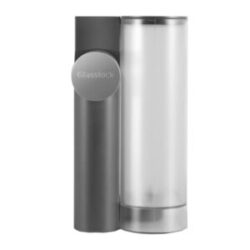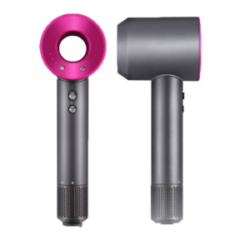| Whether you’re young or old, clueless about physics or studied it all your life, magnets do feel a little bit like magic. There’s something mesmerizing about watching an invisible force make two pieces of metal leap together or fly apart. But magnets aren’t just a quirky glitch of physics that lets you hang pictures on the refrigerator. Magnetism is a force generated whenever there are electrical charges whizzing around, whether it’s the bits that make up the individual atoms or swathes of electrons in electrical currents that power our devices. And the bigger the electrical current, the more powerful the magnetic field! [♪ INTRO] Thanks to Brilliant for supporting this SciShow List Show! To keep building your STEM skills and exploring beyond this video, you can check out Brilliant.org/SciShow. That link will give you 20% off an annual premium subscription! Given its deep link with electricity, it’s no surprise that magnets are a vital part of modern technology, from computer chips to medical devices. But sometimes a little magnet won’t cut it when we want to give something a really big push or pull. So, we got curious about what the strongest magnets humanity has ever created are. Here are five of them, including one so powerful it blew up the whole experiment! One reason we need crazy strong magnets is to peer inside the human body. And there’s no better example than the whopping, 132 metric ton Iseult magnet, developed by French scientists at the NeuroSpin research center as a component of a very powerful MRI machine. Is this the one that exploded? You’re going to find out soon! This enormous magnet needs to be cooled down to –271 degrees celsius! Which is just two degrees above absolute zero, which is the coldest temperature possible. It’s built for medical imaging to give scientists a deeper look into the activity of the human brain. We measure the strength of powerful magnets like this in units of tesla, and the Iseult magnet clocks in at 11.7 tesla. For comparison, a super strong fridge magnet is something like 0.01 tesla, so we’re talking like a thousand times more powerful than that! MRI machines work by making protons inside your body line up with a magnetic field. Then the machine sends a pulse of radio waves that pushes the protons out of alignment. After the pulse is gone, the protons realign with the magnetic field and give off their own radio waves. And the MRI machine can use the pattern of those radio waves to construct an image. Wild! This sounds kind of freaky, but it’s totally harmless! The thing is, small magnets don’t cut it for getting many of the protons deep inside of your body to all point in the same direction, which is why MRI requires such powerful magnets to do the job. Ordinary MRI magnets are somewhere between 1.5 to 3 tesla, but more powerful ones like the Iseult can give us a finer picture of what’s going on inside the body. That’s because the stronger the magnet, the stronger the signal given off by the protons as they realign with the magnetic field after that pulse of radio waves. That helps resolve different features, like small blood vessels, more easily. As for why the actual, physical magnet needs to be so huge and cold, it comes down to how the magnetic field is generated. As we mentioned, the stronger the electrical current producing the field, the stronger the magnet. So as well as having an electric coil big enough to pass a huge current, cooling the equipment down lowers the resistance inside the circuit. In fact, for certain materials, like the ones in the Iseult magnet, the circuit becomes superconducting. That means it has no electrical resistance whatsoever, making it easier to drive a huge electrical current. With this magnet’s absolutely beastly field, neuroscientists are able to study the activation of really particular parts of a person’s brain inside the MRI scanner. That gives us a much more accurate picture of what specific functions each of those tiny regions of the brain do when it comes to the job of making you … you. Including when it goes wrong. By working out the functions of increasingly specific parts of the brain, researchers hope to create new tools for diagnosing patients with neurological or psychiatric disorders. So sometimes, big magnets need cooling down to operate. But we can also use a powerful magnet to contain super high temperatures. Which might even help produce clean energy! In 2021, a team led by MIT and the startup Commonwealth Fusion Systems developed and tested a magnet capable of reaching 20 tesla. The goal is to use this kind of magnet to sustain nuclear fusion, a carbon-free, safe source of energy that produces much less radioactive waste than existing nuclear energy. It’s the same process that powers the sun, where light elements like isotopes of hydrogen fuse into heavier ones, but lose some small amount of mass overall. That missing mass gets converted into energy, as described by Einstein’s famous “E=mc^2”. That’s kinda like the nuclear fission used in existing nuclear power plants, which also convert mass into energy, but by splitting atoms, rather than fusing them. The goal is to get fusion going on Earth, in a way that gives us more energy than the amount we put into the process. But that requires conditions not dissimilar from the core of the sun, which is a very hot whirlwind of atoms called a plasma that needs to be kept stable long enough for fusion to happen and sustain. We’re talking, like, hundreds of millions of degrees! There aren’t any solid materials that can withstand those kinds of temperatures, but it is possible to suspend plasma in mid-air using, you guessed it, a magnetic field. Which is why this kind of fusion is called magnetic confinement fusion. That’s exactly what the magnet at MIT was developed to do. Like Iseult, it’s the superconducting variety of magnet that helps produce the huge current needed for a 20 tesla field. The plans are for the reactor using this kind of magnet to go into operation in 2025 when maybe, just maybe, it will provide a proof of concept for usable nuclear fusion. So, watch this space. Things are getting exciting! We don’t always have to chase the biggest individual magnet, either. Sometimes, we can use a whole bunch of them working together to achieve amazing things, like when we’re accelerating tiny charged particles. And the granddaddy of all particle accelerators is the Large Hadron Collider, or LHC. It’s a 27 km long ring of magnets outside Geneva, Switzerland. Physicists designed it to accelerate protons to near the speed of light so they can be smashed into each other inside detectors, which provide us a sneak peek at the interactions of subatomic particles. All of this tells us about the fundamental forces of nature of our universe, like, for instance, the electromagnetic force. Along that ring of the LHC are 9,600 magnets, some of them 15 meters long, 35 tons, and producing 8 tesla on their own! In scientific terms, that is a butt-load of big magnets. Like the others we talked about, the LHC magnets have to be cooled down to about 2 degrees above absolute zero, which allows them to become superconducting. And superconducting circuits provide the huge electric currents that generate those 8 tesla fields. The point of all these magnets is to keep the protons inside the LHC on track as they whizz around. See, it takes an electric field to actually give the protons energy as they circulate about the LHC, picking up more and more speed before they collide. Electric fields are the close sibling of magnetic fields, they’re also generated by electric charges and push and pull each other around. But electric fields have some differences, and one of them is that they can give charged particles kinetic energy, unlike magnetic fields which can only change the direction of charged particles once they’re already moving. At the LHC, electric fields are designed to give the protons a kick in basically a straight line. It takes the magnetic fields to provide the turning force to keep the protons going around the ring, instead of slamming into the walls of the accelerator. It’s like the magnets are the banked curves of the racetrack, while the electric fields are each race car’s engine. The other thing some of the magnets do is make sure the bunches of protons stay squeezed together along their line of travel around the ring. That makes it easier to slam them into each other inside one of the detectors. And when these protons finally do collide, they break apart to produce all kinds of exotic matter that can tell us about the fundamental laws of nature. The crowning achievement so far is the Higgs boson discovery of 2012, which confirmed our theories on how subatomic particles acquire mass! Now, given the size of the magnets we’ve discussed so far, you might get the feeling that bigger is always better. Turns out, that’s not always the case. In 2022, researchers at the Steady High Magnetic Field Facility in Hefei, China, announced they had reached a 45 tesla magnetic field with a magnet whose central component was no wider than a silver dollar. Like the other magnets we’ve talked about, it has a whole bunch of superconducting coils, but those only produce about 11 tesla of the field. The star of the show is inside those coils, where you’ll find another circuit that’s just 32 millimeters in diameter! Unlike big coils, the tiny electromagnet inside has resistance when the current flows through it. Resistance means it takes a ton of power to keep the magnet going, and, for sure, that makes it expensive to operate. But, unlike a superconducting magnet, resistive magnets aren’t limited in terms of the strength of the magnetic field they can produce. So long as you keep pumping a bigger current through a resistive magnet, its field will keep getting stronger and stronger. And in the Hefei magnet, the tiny resistive magnet can be pushed up to a huge 34 Tesla on its own! Setups like these are called hybrid magnets. They use a combination of the high-current capacity of resistive magnets and low power needed for superconducting magnets to make the most intense, stable magnetic fields we’ve ever created. Recently, researchers implemented a few clever tweaks to this setup, pushing the performance of the overall magnet to 45.22 tesla, just beating the previous record holder at the National High Magnetic Field Laboratory in Florida. One unique use of a magnet this strong is conducting experiments on new materials for electronics, like carbon nanotubes. Those are “tubes” of carbon, just one atom thick that are really good at carrying electrical currents. Because they conduct electricity so well and are extremely thin, in theory, a computer processor made of carbon nanotubes instead of ordinary silicon could be three times faster and energy efficient at the same time! Since electrical currents and magnetic properties are intricately linked, a powerful magnetic field like the Hefei magnet helps us study the electric properties of carbon nanotubes. So ultra strong magnets might help us take steps towards more energy efficient electronics in the future. Hybrid magnets are great because they produce strong but stable fields that stick around long enough for us to do experiments with. But what if we don’t care about stability at all? What if we’re happy to throw everything into just making one heck of a magnetic field? Well, in that case, it’s actually possible to achieve 1,200 tesla! In 2018, a team of researchers at the University of Tokyo in Japan did just that. The trick was starting off with a strong-ish field of 3 tesla (which, remember, is very strong) created inside of a thin copper tube, and then squeezing that field into a very small area. Physicists call the amount of magnetism in a given region of space “flux density”. The higher the flux density, the stronger the magnetic field. So if you can “squeeze” the flux into a tighter space, you can increase the field strength. This process is called electromagnetic flux-compression. The University of Tokyo team achieved compression with a bank of electronic components called capacitors, which store up a bunch of electric energy. Surrounding the thin copper tube was a steel coil. When all the energy stored up in the capacitors was released through 480 cables into that coil, it created a massive magnetic field, causing the thin copper tube to implode. So that first, 3 tesla magnetic field was suddenly squeezed into a much tinier space. And that is what produced the unbelievably powerful, 1,200 tesla magnet. If you want an idea of how insanely strong that is, the materials used in the set up weren’t even made to withstand the force of magnetism produced by the field. So the whole experiment literally, and intentionally, exploded immediately after the field was produced. Which is awesome… and totally impractical for most scientific purposes. But, in this particular experiment, the whole idea was to see exactly how far things could go with flux compression, so that explosion was actually the sign of great progress! What’s more, even for the short time they exist, ultra strong magnetic fields like these can help probe what happens to matter when under really extreme conditions, like when subatomic particles like electrons get ripped off of atoms. And with new frontiers of research available thanks to powerful magnets like these, it’s no wonder that strong magnetic fields are as attractive to scientists as they are to metals. If you’re attracted to magnets, you’ll love Brilliant’s Electricity and Magnetism course! This interactive course helps you learn about magnetic fields and all sorts of physical laws that let them do their thing. And with Brilliant, you’re actively learning. The filmed demos in this course give you the chance to see magnetism in action and apply the principles you’re learning to better understand the devices you interact with every day. But there’s so much to explore in the world that you interact with daily. And Brilliant’s online learning platform offers guided courses in way more than just magnetism. You can take a range of courses in math, science, and engineering, all with a focus on problem-solving. To get started with Brilliant today, you can click the link in the description down below, which gives you 20% off an annual Premium Brilliant subscription. Before you commit to a year with Brilliant, you can try it for free using that link or by visiting Brilliant.org/SciShow. Thanks to Brilliant for supporting this SciShow video and thank you for sticking around to the end of it. What an episode it was! I have to just give some props to our team here. Some of the most complicated ideas in science communication all compressed into one video about the biggest and most awesome magnets in the world. Thats amazing work! So I’m really grateful to Brilliant for supporting it and grateful to you for supporting it as well. [♪ OUTRO] | 无论您是年轻还是年老, 对物理一窍不通还是研究了一辈子, 磁铁确实有点像魔法。 使两块金属 跳跃在一起或飞散,这让人着迷。 但磁铁不仅仅是 让你把照片挂在冰箱上的古怪的物理学故障。 每当 有电荷在周围呼啸而过时, 无论是构成单个原子的比特, 还是为我们的设备供电的电流中的电子带,磁性都会产生 。 电流越大 ,磁场越强! [♪ 简介] 感谢 Brilliant 支持本次 SciShow List Show! 要继续培养您的 STEM 技能 并探索此视频以外的内容, 您可以访问 Brilliant.org/SciShow。 该链接将为您 提供年度高级订阅 20% 的折扣! 鉴于它与电的密切联系,从计算机芯片到医疗设备 ,磁铁成为现代技术的重要组成部分也就不足为奇了 但有时, 当我们想给某物 一个很大的推力或拉力时,一点磁铁也起不到作用。 因此,我们很好奇 人类创造的最强磁体是什么。 这里有五个,其中一个非常 强大,以至于炸毁了整个实验! 我们需要疯狂的强力磁铁的原因之一 是为了观察人体内部。 没有比重达 132 公吨的 Iseult 磁铁更好的例子了,它 是由法国科学家 在 NeuroSpin 研究中心开发的, 作为非常强大的 MRI 机器的一个组件。 爆炸的就是这个? 你很快就会知道的! 这个巨大的磁铁需要 冷却到 –271 摄氏度! 这仅比绝对 零高两度,这是可能的最冷温度。 它专为医学成像 而打造,可让科学家更深入地了解 人脑的活动。 我们 以特斯拉为单位测量像这样的强力磁铁的强度, 而 Iseult 磁铁时钟的强度为 11.7 特斯拉。 相比之下,超强冰箱 磁铁大约是 0.01 特斯拉, 所以我们说的是 比这强一千倍! MRI 机器的工作原理是让 您体内的质子与磁场对齐。 然后机器发出无线电波脉冲 ,将质子推离对齐。 脉冲消失后,质子 与磁场重新对齐 并发出自己的无线电波。 MRI 机器可以使用 这些无线电波的模式来构建图像。 荒野! 这听起来有点怪异, 但完全无害! 问题是,小磁铁无法 让身体深处的许多质子 全部 指向同一方向, 这就是为什么 MRI 需要如此 强大的磁铁来完成这项工作。 普通 MRI 磁体的能量介于 1.5 到 3 特斯拉之间,但 像 Iseult 这样更强大的磁体可以让我们更 清楚地了解体内发生的事情。 这是因为磁铁 越强,质子 这有助于更轻松地解决不同的特征 ,例如小血管。 至于为什么实际的物理 磁铁需要如此巨大和寒冷, 这取决于 磁场是如何产生的。 正如我们提到的, 产生磁场的电流 越强,磁铁就越强。 因此,除了具有足够大的电线圈 以通过巨大的电流外, 冷却设备还可以降低 电路内的电阻。 事实上,对于某些材料, 例如 Iseult 磁体中的材料 ,电路会变得超导。 这意味着它没有任何电阻 ,因此更容易 驱动巨大的电流。 凭借这块磁铁绝对强大的 磁场,神经科学家能够研究 这让我们更准确地了解 大脑的每个微小区域在 制造你……你时的具体功能。 包括出错的时候。 通过 研究大脑越来越具体的部分的功能,研究人员 希望创造新的工具来诊断 患有神经或精神疾病的患者。 所以有时,大磁铁 需要冷却才能运行。 但我们也可以使用强大的磁铁 来容纳超高温。 这甚至可能有助于产生清洁能源! 2021 年,由麻省理工学院和 初创公司 Commonwealth Fusion Systems 领导的团队 开发并测试了一种 能够达到 20 特斯拉的磁铁。 目标是使用这种 磁铁来维持核聚变,这是 一种无碳、安全的能源 ,产生的放射性 废物比现有的核能少得多。 这与为太阳提供动力的过程相同,在 太阳中,氢同位素等轻元素 融合成较重的元素,但 总体上会损失少量质量。 正如爱因斯坦著名的“E=mc^2”所描述的那样,丢失的质量会转化为能量。 这有点像 现有核电站中使用的核裂变, 它也将质量转化为能量,但通过 分裂原子,而不是融合它们。 我们的目标是在地球上进行核聚变, 以一种为我们提供比我们投入过程中的能量更多的能量的方式 。 但这需要 与太阳核心相似的条件,太阳核心 是一种非常热的原子旋风, 称为等离子体,需要保持稳定 足够长的时间才能发生和维持聚变。 我们说的 是几亿度! 没有任何固体材料可以 承受这种温度, 但可以使用磁场将等离子体悬浮在半空中 。 这就是为什么这种聚变被 称为磁约束聚变。 这正是 麻省理工学院开发磁铁的目的。 与 Iseult 一样,它是一种超导 磁体,有助于 产生 20 特斯拉场所需的巨大电流。 计划是让使用这种磁铁的反应堆 在 2025 年投入运行, 届时也许,只是也许,它将 为可用的核聚变提供概念证明。 所以,注意这个空间。 事情越来越精彩了! 我们也不必总是追逐 最大的个体磁铁。 有时,我们可以使用 一大堆它们一起工作 来实现惊人的事情,比如当 我们加速微小的带电粒子时。 所有粒子加速器的鼻祖 是大型强子对撞机 (LHC)。 这是瑞士日内瓦郊外一个 27 公里长的磁铁环 。 物理学家设计它是为了将 质子加速到接近光速, 这样它们就可以 在探测器内相互撞击, 这让我们得以一窥 亚原子粒子的相互作用。 所有这些都告诉 我们宇宙中自然界的基本力 ,例如电磁力。 大型强子对撞机的那个环上有 9,600 块磁铁, 其中一些长 15 米,重 35 吨, 并且可以自行产生 8 特斯拉! 用科学术语来说,那是 一大堆大磁铁。 就像我们谈到的其他人一样, 大型强子对撞机的磁体必须冷却到 绝对零以上约 2 度,这 使它们能够变得超导。 超导电路 提供产生这 8 特斯拉场的巨大电流。 所有这些磁铁的目的 是让大型强子对撞机内的质子在 旋转时保持在轨道上。 看,当质子在大型强子对撞机周围循环时,需要一个电场才能真正为其 提供能量, 电场是磁场的近亲 , 它们也是由电荷产生 并相互推拉。 但电场有一些不同之处, 其中之一是它们可以为 带电粒子提供动能,这 与磁场不同,磁场 只能在带电 粒子移动后改变方向。 在大型强子对撞机中,电场的 设计目的是使 质子基本上沿直线运动。 它需要磁场来 提供旋转力来保持 质子绕着环运动,而不是猛烈 撞击加速器的壁。 就像磁铁 是赛道的倾斜曲线, 而电场 是每辆赛车的引擎。 一些磁铁做的另一件事 是确保质子束 沿着它们绕环行进的路线保持挤压在一起 。 这使得它们更容易 在其中一个探测器内相互撞击。 当这些质子最终发生碰撞时, 它们会分裂产生 各种奇异物质,这些物质可以告诉我们 自然界的基本规律。 迄今为止的最高成就 是 2012 年希格斯玻色子的发现, 它证实了我们关于 亚原子粒子如何获得质量的理论! 现在,鉴于 我们目前讨论的磁铁尺寸, 您可能会 觉得越大越好。 事实证明,情况并非总是如此。 2022 年,位于中国合肥的稳定强 磁场设施的研究人员 宣布,他们已经 使用中心 部件不超过银元的磁铁达到了 45 特斯拉的磁场。 就像我们讨论过的其他磁铁一样 ,它有 一大堆超导线圈,但这些线圈只能 产生大约 11 特斯拉的磁场。 亮点就在这些线圈内部 ,您会在其中找到另一个 直径仅为 32 毫米的电路! 与大线圈不同,内部的微小 电磁铁 在电流流过时会产生电阻。 阻力意味着需要大量 的能量来保持磁铁的 运转,当然,这使得操作成本很高。 但是,与超导磁体不同, 电阻磁体 在 它们可以产生的磁场强度方面不受限制。 只要你不断地 通过电阻磁铁泵送更大的电流, 它的磁场就会越来越强。 而在合肥磁铁中,微小的 电阻磁铁可以 自行推到巨大的 34 特斯拉! 像这样的设置被称为混合磁铁。 它们结合 了电阻磁体的高电流容量 和超导磁体所需的低功率, 以产生我们创造过的最强烈、最 稳定的磁场。 最近,研究人员 对该设置进行了一些巧妙的调整, 将整体磁铁的性能提高 到 45.22 特斯拉,刚刚打破了佛罗里达 州国家高 磁场实验室之前的记录保持者。 如此强大的磁铁的一项独特用途是 对新的电子材料( 如碳纳米管)进行实验。 这些是碳“管”,只有 一个原子厚,非常 适合传输电流。 因为它们导电性 好而且非常薄,理论上, 由碳纳米管而不是普通硅制成的计算机处理器 可以同时快三倍和 节能! 由于电流和 磁性有着千丝万缕的联系, 像合肥磁铁这样的强大磁场 可以帮助我们研究 碳纳米管的电学特性。 因此,超强磁铁可能会帮助我们在未来 朝着更节能的 电子产品迈进。 混合磁铁很棒,因为 它们会产生强大而稳定的磁场,这些磁场 会持续足够长的时间 供我们进行实验。 但是,如果我们根本不关心稳定性呢? 如果我们乐于将所有东西都投入到 只制造一个磁场中怎么办? 那么,在那种情况下,实际上 有可能达到 1,200 特斯拉! 2018 年, 日本东京大学的一组研究人员就这样做了。 诀窍是从在薄铜管内部 产生 3 特斯拉的强场 (请记住,非常强)开始 , 然后将该 场挤压到一个非常小的区域。 物理学家 将给定空间区域中的磁量称为“通量密度”。 磁通密度 越高,磁场越强。 因此,如果您可以将通量“挤压”到更紧密的 空间中,就可以增加场强。 这个过程称为 电磁通量压缩。 东京大学的团队 通过一 组称为电容器的电子元件实现了压缩,这些元件可以 储存大量电能。 细铜管周围是钢线圈。 当储存在电容器中的所有能量 通过 480 根电缆释放 到线圈中时,它会产生巨大的 磁场,导致薄铜管内爆。 所以首先,3 特斯拉的磁场 突然被压缩到一个更小的空间中。 这就是产生 令人难以置信的 1,200 特斯拉磁铁的原因。 如果你想知道它的强度有多疯狂 ,那么设置中使用的材料 甚至无法承受 磁场产生的磁力。 因此,整个实验 实际上是有意地 在场产生后立即爆炸。 这太棒了……而且 对于大多数科学目的来说完全不切实际。 但是,在这个特定的实验中,整个 想法是要确切地了解事物 在通量压缩方面能走多远,因此 爆炸实际上是取得巨大进步的标志! 更重要的是,即使它们存在的时间很短 ,像这样的超强磁场 也可以帮助探测 在真正极端的条件下会发生什么, 比如当电子等亚原子 粒子从原子中剥离出来时。 由于这些强大的磁铁,有了新的研究前沿, 对科学家的吸引力与 对金属的吸引力一样大。 如果您被磁铁吸引,您一定会喜欢 Brilliant 的电磁学课程! 此互动课程可帮助 您了解磁场 以及 让它们发挥作用的各种物理定律。 有了 Brilliant,您正在积极学习。 本 课程中的视频演示让您有 机会看到磁力的作用,并 应用您正在学习的原理 来更好地理解 您每天与之交互的设备。 但是,在 您每天要与之互动的世界中,有太多值得探索的地方。 Brilliant 的在线学习 平台提供的指导 课程不仅仅是磁力。 您可以选修一系列 数学、科学和工程课程, 所有课程都侧重于解决问题。 要立即开始使用 Brilliant,您可以 单击下方说明中的链接, 这可为您提供年度 Premium Brilliant 订阅的 20% 折扣。 在您承诺使用 Brilliant 一年之前, 您可以使用该链接 或访问 Brilliant.org/SciShow 免费试用。 感谢 Brilliant 支持此 SciShow 视频, 并感谢您 坚持到最后。 这是多么精彩的一集啊! 我必须在这里给我们的团队一些支持。 科学传播 中一些最复杂的想法 全部压缩 到一个关于世界上最大、 最棒的磁铁的视频中。 那是了不起的工作! 所以我真的很感谢 Brilliant 对它的支持,也 很感谢你对它的支持。 [♪结尾] |










